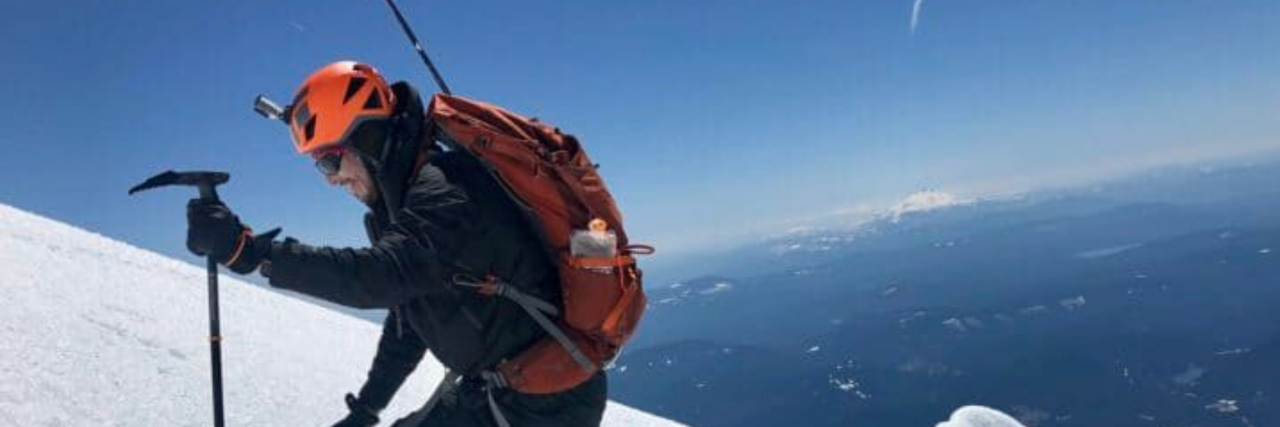For the outdoor community, the 50 High Points challenge represents the ultimate accomplishment: hike to the top of the highest peak in each of the 50 United States. Only about 300 people have completed the challenge. It’s the kind of athletic achievement most people assume you can’t complete if you live with any kind of health challenge or disability. But last year, my friend Michael Shelver and I set out to prove them wrong by attempting the high point challenge while living with type 1 diabetes — and we gave ourselves an extra hurdle by setting a goal of completing the challenge in just 50 days. Along the way, our “Project 50-in-50” brought members of the diabetes community together and showed that with the right tools and support, people living with type 1 diabetes can scale even the highest peaks (literally!).
Looking back, Project 50-in-50 seems like it was destined to be a part of my and Michael’s story from the time we met. We were both diagnosed with type 1 diabetes when we were kids, and first became friends in 2015 through the Diabetes Youth Families nonprofit. We hit it off on a backpacking trip where we discovered how much we both love the outdoors as well as being engaged in the diabetes community.
We started talking about ways we could combine our love of the outdoors with diabetes advocacy, because in our experience, being active helps build confidence when you have diabetes. After learning about the 50 High Points challenge, we knew we had to do it, especially because no one with type 1 diabetes had completed the challenge before. I wanted to not only push my own limits, but also prove that type 1 diabetes doesn’t have to stop you from getting outdoors.
To prepare for our expedition, we spent months planning how we’d drive from peak to peak and the supplies we’d need to manage our diabetes. We both used the Dexcom G6 Continuous Glucose Monitoring System. The Dexcom G6 uses a small, wearable sensor and transmitter to continuously measure and send glucose levels wirelessly to a smart device or receiver, giving real-time glucose data without the need to prick your finger. The system also offers customizable alerts and alarms to help avoid dangerous low and high blood sugar events and a function that allows you to share my glucose data in real time with up to 10 followers.
This system was crucial because exercise can cause blood glucose to drop, while high altitude can cause blood glucose to rise; in addition, our eating habits would be thrown out of whack since we would have to rely on portable snacks on the trail and quick hot food on the road. Being able to check our blood glucose in real-time allowed us to easily notice if our levels were heading too high or too low, and adjust accordingly before our levels hit dangerous territory. This trip wouldn’t have been possible without the technology and especially the G6 CGM, because our schedules varied so much and we never really got into a rhythm.
The adventure began at Denali, Alaska’s highest peak, which has an elevation of 20,310′ and took nine days to summit. That summit marked the official start of our 50-day time clock. From there, we flew to Hawaii to climb Mauna Kea; then, we started our journey through the lower 48 states at Charles Mound, Illinois. As we continued our trek throughout the country, driving from mountain to mountain (sometimes two or three times in one day!) we blogged and shared updates on social media, and met up with other diabetes warriors who came out to support us on the trail. Hearing their stories and enthusiasm for our project gave us strength for our journey and inspired us to keep proving to the world what people with type 1 diabetes can do.
Though we did encounter a few blood glucose highs and lows, the biggest hurdle of our project came on day 21, peak #36, at Granite Peak in Montana. While climbing down an ice field, I slipped and fell into some rocks; then, Michael fell 150 yards and crashed into rocks at high speed. A search and rescue helicopter took us off the mountain and brought us to the hospital, where it was determined that Michael would need to fly home to California to recover from his injuries. I continued on with the project, and Michael re-joined me at peak #46, Mount Elbert in Colorado. If diabetes has taught us anything, it’s how to navigate challenges with a positive mental attitude and the determination to keep fighting through health setbacks.
On day 49, we made it to the top of peak #50, Guadalupe Peak in Texas, marking the completion of Project 50-in-50. It was an incredible feeling. When I look back on our journey, I’m overwhelmed by the amount of support we received from the diabetes community, and the sense of empathy we all share because we’re all facing life with this condition.
In reality, climbing mountains and living with diabetes share a lot of similarities. It’s easy to become overwhelmed if you’re always worried about a larger goal, like summiting a mountain or achieving a “perfect” A1C. Some days, you just have to focus on putting one foot in front of the other, relying on a solid support system, and accepting that some days are going to go better than others. What matters is maintaining a positive mental attitude and putting in the effort, each and every day.
Patrick Mertes is a paid spokesperson of Dexcom, Inc.
*Dexcom CGM Systems are permitted for use between altitudes of -1,300 and 13,800 feet. See Instructions for Use in the Dexcom G6 User Guide


